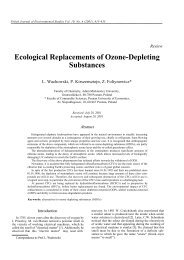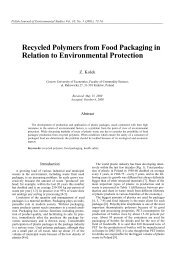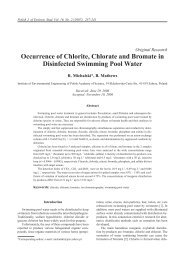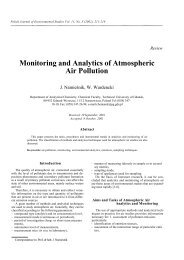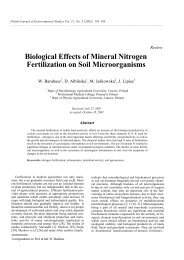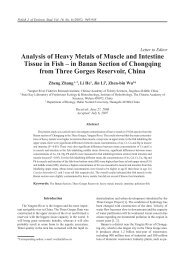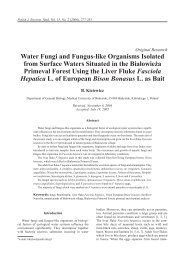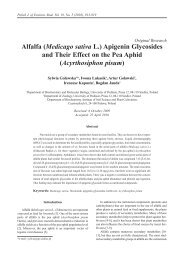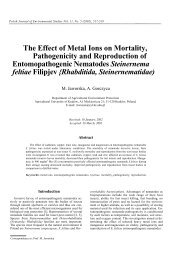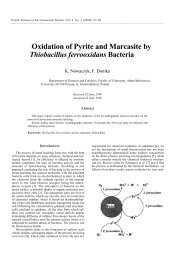Methylene Blue and Phenol Photocatalytic Degradation on ...
Methylene Blue and Phenol Photocatalytic Degradation on ...
Methylene Blue and Phenol Photocatalytic Degradation on ...
Create successful ePaper yourself
Turn your PDF publications into a flip-book with our unique Google optimized e-Paper software.
690 Bubacz K., et al.<br />
Our results corresp<strong>on</strong>ded with an observati<strong>on</strong> that has been<br />
made by other authors. According to Ling [23], basic pH<br />
electrostatic interacti<strong>on</strong>s between negative TiO¯ <str<strong>on</strong>g>and</str<strong>on</strong>g> methylene<br />
blue cati<strong>on</strong> leads to a str<strong>on</strong>g adsorpti<strong>on</strong> with a corresp<strong>on</strong>ding<br />
high rate of degradati<strong>on</strong>. Here it should be c<strong>on</strong>cluded<br />
that pH affects the adsorpti<strong>on</strong> properties of organic<br />
compounds <str<strong>on</strong>g>and</str<strong>on</strong>g> their dissociating state in a soluti<strong>on</strong>. The<br />
surface charge properties of TiO 2 also changed with the<br />
changes of pH value due to the amphoteric behaviour of<br />
semi c<strong>on</strong>ducting TiO 2 [7, 16, 17, 23, 24].<br />
In Figs. 6 <str<strong>on</strong>g>and</str<strong>on</strong>g> 7 the removal of TOC in soluti<strong>on</strong>s of phenol<br />
<str<strong>on</strong>g>and</str<strong>on</strong>g> methylene blue at different pH during an illuminati<strong>on</strong><br />
period was presented as well. In the case of phenol<br />
soluti<strong>on</strong> after 6 h of irradiati<strong>on</strong> at pH=6.5, the percentage of<br />
photocatalytic decompositi<strong>on</strong> of phenol in aqueous TiO 2<br />
suspensi<strong>on</strong> was the highest, but the removal of TOC <strong>on</strong>ly<br />
reached 5.87%. It was the lowest result corresp<strong>on</strong>ding with<br />
soluti<strong>on</strong>s of phenol at other pH. TOC analysis shows degradati<strong>on</strong><br />
that leads to the c<strong>on</strong>versi<strong>on</strong> of organic compounds<br />
into harmless gaseous CO 2 <str<strong>on</strong>g>and</str<strong>on</strong>g> inorganic i<strong>on</strong>s [25]. After 6<br />
h of irradiati<strong>on</strong>, mineralizati<strong>on</strong> was not enough. However,<br />
the removal of TOC after an extensi<strong>on</strong> for a 14-h irradiati<strong>on</strong><br />
period at the same value of pH was almost 25%. The mineralizati<strong>on</strong>s<br />
for soluti<strong>on</strong>s at pH=3, 7.2, <str<strong>on</strong>g>and</str<strong>on</strong>g> 9 achieved<br />
25.19%, 28.87%, <str<strong>on</strong>g>and</str<strong>on</strong>g> 22.18%, respectively. The obtained<br />
results show that the mineralizati<strong>on</strong> of phenol does not<br />
immediately follow the degradati<strong>on</strong> of the soluti<strong>on</strong>. At the<br />
beginning, intermediates were present, which underwent<br />
further photocatalytic oxidati<strong>on</strong>. A decolorizati<strong>on</strong> of soluti<strong>on</strong>s<br />
of methylene blue also produced TOC disappearance.<br />
The photocatalytic degradati<strong>on</strong> of the analyzed dye<br />
reached, for example, given the natural pH equal to 5.8 <str<strong>on</strong>g>and</str<strong>on</strong>g><br />
after 6 h of irradiati<strong>on</strong> the removal of TOC amounting to<br />
3.99%. Then the soluti<strong>on</strong> was additi<strong>on</strong>ally illuminated for 4<br />
hours. At this time the extent of degradati<strong>on</strong> increased to<br />
28.29%. The tendency to later total organic carb<strong>on</strong> decrease<br />
in comparis<strong>on</strong> with c<strong>on</strong>centrati<strong>on</strong> of the organic compound<br />
was observed here as well.<br />
C<strong>on</strong>clusi<strong>on</strong>s<br />
In the present investigati<strong>on</strong>s, an industrial hydrolyzed<br />
TiOSO 4 was used as the precursor for preparati<strong>on</strong> of a photocatalyst<br />
after amm<strong>on</strong>ia treatment. During studying characterizati<strong>on</strong><br />
of the photocatalyst, the absence of nitrogen in<br />
TiO 2 structure was c<strong>on</strong>firmed by FTIR/DRS spectra of the<br />
titania. The prepared TiO 2 had photocatalytic efficiency<br />
under UV light <strong>on</strong>ly because of the presence of <strong>on</strong>e absorpti<strong>on</strong><br />
edge in the UV regi<strong>on</strong> according to UV-Vis/DR measurements.<br />
The mean particle size of the studied material<br />
was found to be 197.5 nm, while the average size of crystallites<br />
increased to 12.7-13 nm. The nanostructured material<br />
of the sample <str<strong>on</strong>g>and</str<strong>on</strong>g> the presence of amorphous <str<strong>on</strong>g>and</str<strong>on</strong>g> crystalline<br />
phases in the photocatalyst were revealed by TEM<br />
analysis as well. It was found that the pH value of the soluti<strong>on</strong><br />
str<strong>on</strong>gly influences the photocatalysis degradati<strong>on</strong> of<br />
organic compounds under UV radiati<strong>on</strong>. The photocatalytic<br />
decompositi<strong>on</strong> of phenol was most efficient at pH=6.5.<br />
However, in the case of applied methylene blue dye soluti<strong>on</strong><br />
high photocatalytic activity was preferred by basic<br />
reacti<strong>on</strong>. The mineralizati<strong>on</strong> of phenol <str<strong>on</strong>g>and</str<strong>on</strong>g> methylene blue<br />
measured by a level of TOC showed a similar tendency to<br />
remove organic compounds like UV-Vis spectrometry,<br />
which c<strong>on</strong>firms photocatalytic mineralizati<strong>on</strong> reacti<strong>on</strong>s<br />
c<strong>on</strong>ducted using the prepared TiO 2 .<br />
References<br />
1. TANG W. Z., AN H. UV/TiO 2 photocatalytic oxidati<strong>on</strong> of<br />
commercial dyes in aqueous soluti<strong>on</strong>s. Chemosphere 31,<br />
4157, 1995.<br />
2. MOHAPATRA P., PARIDA K.M. <str<strong>on</strong>g>Photocatalytic</str<strong>on</strong>g> activity of<br />
sulfate modified titania 3: Decolorizati<strong>on</strong> of methylene blue<br />
in aqueous soluti<strong>on</strong>. J. Mol. Catal. A: Chemical 258, 118,<br />
2006.<br />
3. LACHHEB H., PUZENAT E., HOUAS A., KSIBI M.,<br />
ELALOUI E., GUILLAND CH., HERRMANN J. M.<br />
<str<strong>on</strong>g>Photocatalytic</str<strong>on</strong>g> degradati<strong>on</strong> of various types of dyes (Alizarin<br />
S, Crocein Orange G, Methyl Red, C<strong>on</strong>go Red, <str<strong>on</strong>g>Methylene</str<strong>on</strong>g><br />
<str<strong>on</strong>g>Blue</str<strong>on</strong>g>) in water by UV-irradiated titania. Appl. Catal. B:<br />
Envir<strong>on</strong>mental 39, 75, 2002.<br />
4. CHIOU CH. H., WU CH. Y., JUANG R. S. Influence of<br />
operating parameters <strong>on</strong> photocatalytic degradati<strong>on</strong> of phenol<br />
in UV/TiO 2 process. Chem. Eng. J. 139, 322, 2008.<br />
5. AKBAL F., NUR ONAR A. <str<strong>on</strong>g>Photocatalytic</str<strong>on</strong>g> degradati<strong>on</strong> of<br />
phenol. Envir<strong>on</strong>. M<strong>on</strong>it. Asses. 83, 295, 2003.<br />
6. FORGACS E., CSERHÁTI T., OROS G. Removal of synthetic<br />
dyes from wastewaters: a review. Envir<strong>on</strong>. Int. 30,<br />
953, 2004.<br />
7. SENTHILKUMAAR S., PORKODI K., GOMATHI R.,<br />
MAHESWARI GEETHA A., MANONMANI N. Sol-gel<br />
derived silver doped nanocrystalline titania catalysed photodegradati<strong>on</strong><br />
of methylene blue from aqueous soluti<strong>on</strong>.<br />
Dyes <str<strong>on</strong>g>and</str<strong>on</strong>g> Pigments 69, 22, 2006.<br />
8. BIZANI E., FYTIANOS K., POULIOS I., TSIRIDIS V.<br />
<str<strong>on</strong>g>Photocatalytic</str<strong>on</strong>g> decolorizati<strong>on</strong> <str<strong>on</strong>g>and</str<strong>on</strong>g> degradati<strong>on</strong> of dye soluti<strong>on</strong>s<br />
<str<strong>on</strong>g>and</str<strong>on</strong>g> wastewaters in the presence of titanium dioxide. J.<br />
Hazard. Mater. 136, 85, 2006.<br />
9. HAJD SALAH N., BOUHELASSA M., BEKKOUCHE S.,<br />
BOULTIF A. Study of photocatalytic degradati<strong>on</strong> of phenol.<br />
Desalinati<strong>on</strong> 166, 347, 2004.<br />
10. COLÓN G., HIDALGO M. C., NAVÍO J. A., PULIDO<br />
MELIÁN E., GONZÁLEZ DÍAZ O., DOÑA J.M. Influence<br />
of amine template <strong>on</strong> the photoactivity of TiO 2 nanoparticles<br />
obtained by hydrothermal treatment. Appl. Catal. B:<br />
Envir<strong>on</strong>mental 78, 176, 2008.<br />
11. WANG Y., ZHANG J., JIN Z., WU Z., ZHANG S. Visible<br />
light photocatalytic decolorati<strong>on</strong> of methylene blue <strong>on</strong><br />
novel N-doped TiO 2 . Chinese Sci. Bull. 52, (15), 2157,<br />
2007.<br />
12. WU CH. H. Effects of operati<strong>on</strong>al parameters <strong>on</strong> the decolorizati<strong>on</strong><br />
of C. J. Reactive Red 198 in UV/TiO 2 -based system.<br />
Dyes <str<strong>on</strong>g>and</str<strong>on</strong>g> Pigments 77, 31, 2008.<br />
13. KUO W. S., HO. P. H. Solar photocatalytic decolorizati<strong>on</strong> of<br />
methylene blue in water. Chemosphere 45, 77, 2001.<br />
14. LAKSHMI S., RENGANATHAN R., FUJITA S. Study <strong>on</strong><br />
TiO 2 -mediated photocatalytic degradati<strong>on</strong> of methylene<br />
blue. J. Photochem. Photobiol. A: Chemistry 88, 163,<br />
1995.



